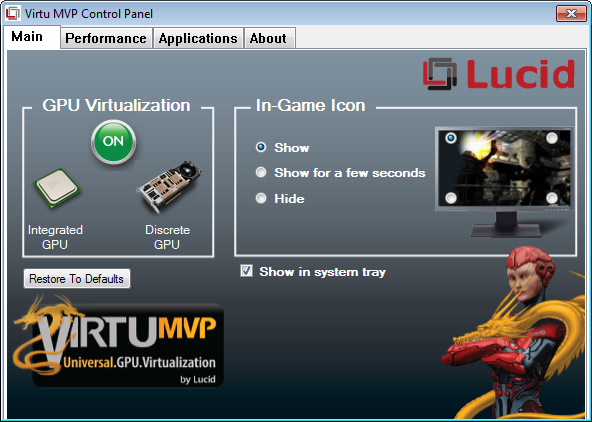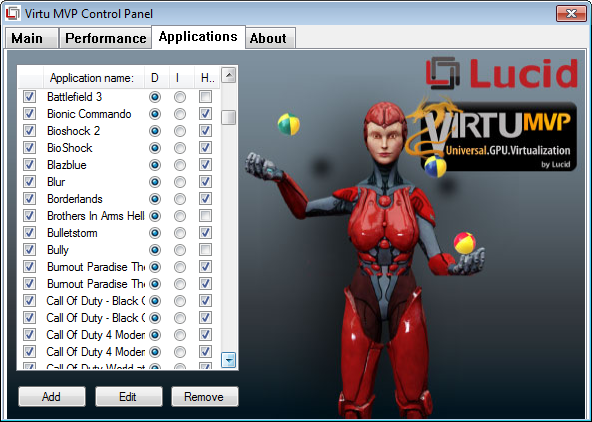Intel’s Z77 Express And Lucidlogix MVP: New Features For Gamers
Integrated USB 3.0, advanced management features, reduced power consumption, and a new software package from Lucidlogix separate the Z77 Express motherboards from the Z68 chipset that preceded it. Were these capabilities worth waiting for?
MVP Is Much More Than Virtu
Lucidlogix Virtu software is famed for its ability to combine the performance of Intel's Quick Sync media encode/decode capabilities with a 3D-performance boosting add-in GPU. When its I-mode configuration, which saw all display output run through processor graphics to cut power consumption from the discrete GPU, resulted in small performance and game compatibility issues, the firm added D-mode to let the graphics card operate natively. And all was well in the world of gamers with a penchant for converting their favorite video files to more easily digestible sizes and formats.
MVP retains the familiar Virtu GPU-tasking capabilities, while adding a couple 3D features: Virtual Vsync to reduce screen tearing and HyperFormance to increase frame rates.
Screen tearing is a phenomenon where more than one frame is displayed within a single draw on the screen. Traditional v-sync addresses this by aligning each frame’s output to a single draw cycle, reducing the maximum frames per second to the refresh rate of the monitor (typically 60 Hz). All frames are first completed by the GPU, and those that aren’t synchronous to the display refresh are removed from the output after completion. A frame must be displayed multiple times whenever the GPU’s output capability drops below 60 FPS, resulting in stuttering.
Virtual Vsync attempts to accomplish a similar task without the 60 FPS cap by analyzing rendering time, then instructing the GPU not to start the process on frames that might be later dropped. Preemptive frame elimination reassigns the rendering time that would have been spent on a dropped frame to the next frame, theoretically reducing stuttering. Yet, because this isn’t actual v-sync, it’s still possible to send two frames in a single refresh cycle, and the monitor only displays the first, resulting in an image that appears synced at 60 FPS, even though an app like Fraps will report performance greater than 60 FPS. In fact, this is the test scenario Lucidlogix prefers, reminding us that games that run slower than 60 FPS won't see any benefit from Virtual Vsync.
HyperFormance goes a little further than Virtual Vsync by attempting to preemptively remove any frames that wouldn’t be finished before the next frame is scheduled, again reassigning that rendering time to the next frame. Ideally, average FPS should be increased since partial frames don't tie up rendering resources. The only potential problem with this technology is game compatibility.
While the majority of games are HyperFormance-capable, a few notable exceptions include Battlefield 3 and Metro 2033. HyperFormance can still be enabled in those unvalidated titles by checking the “H” column box next to the game in Virtu MVP Control Panel.
Get Tom's Hardware's best news and in-depth reviews, straight to your inbox.
Current page: MVP Is Much More Than Virtu
Prev Page Z77 Express: USB 3.0 And Enhanced Manageability Next Page Test Settings And Benchmarks-
-Fran- Wasn't the MVP software to account for the "dips" in performance for discrete video cards?Reply
Could you guys provide a video showing the differences between a run with the MVP and without? With V-Sync on also.
Nice review, BTW. Thanks for it 8)
Cheers! -
confish21 Tom, should we expect much of an advantage when ivy bridge is used?Reply
IB and z77 VS. IB and z68? -
s3anister On page three you label the MSI Z68A-GD80 motherboard as Intel Z77 Express when it should obviously be Z68.Reply
Made me do a double take! -
s3anister confish21Tom, should we expect much of an advantage when ivy bridge is used?IB and z77 VS. IB and z68?Reply
Don't expect them to tell you, they're still under Intel's NDA. -
nebun is this a joke? we need to have at lease 2 pcie lanes at 16x speed for serious gaming...2 lanes at 8x will be bringing down your true capability of the graphic cards...thanks but not thanks...i will stick with my x58 chip for nowReply -
jaquith aicomYou bolded PCIE 2.0 for Panther Point but forgot to change it to PCIE 3.0No, the Z77 and all Panther Point chipest are indeed 8x lanes of PCIe 2.0, so Thomas's article is correct. Don't confuse GPU PCIe lanes with Chipset PCIe lanes. However, Thomas knows that I too 'wish' the LGA 1155 was PCIe 3.0 clean, it sure would help with other chipset 'sharing' issues (bottlenecks).Reply -
josejones Where's the performance increase with the z77 over the z68? The new features are a plus but, previews I've seen so far suggest that the z77's are slower than the z68.Reply
What's up with that? Do the z77's require the Ivy Bridge CPU to take full advantage? Sounds like possible driver and/or most likely BIOS issues as others have pointed out elsewhere on page 2 of the z77 Motherboard Discussion thread. -
tmk221 This Lucidlogix Virtu software looks very promising. Certainly it needs a lot of improvment but I think that they will do good job having intel as a partnerReply -
thehidecheck nebunis this a joke? we need to have at lease 2 pcie lanes at 16x speed for serious gaming...2 lanes at 8x will be bringing down your true capability of the graphic cards...thanks but not thanks...i will stick with my x58 chip for nowpoppycock, even high end cards can't even come close to saturateing a 8x slotReply
http://www.youtube.com/watch?v=NFMzRZqFh-w get learned yo



